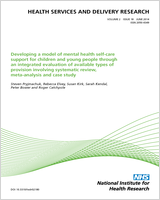| Population |
|---|
| INCOME: % population in an area that live in income-deprived families | IMD 2010 | 15 (11–19) | 7–33 | 60 | < 0.001 | + |
| EMPLOYMENT: % population with employment deprivation | IMD 2010 | 6 (5–8) | 3–12 | 72 | < 0.001 | + |
| ETHNICITY: % population minority ethnic | ONS | 9 (5–20) | 3–63 | 9 | < 0.001 | + |
| OVER75: % population aged 75 or over | ONS | 7 (7–9) | 3–13 | 18 | < 0.001 | – |
| ALONE: % pensioners living alone | ONS | 6 (5–6) | 3–8 | < 1 | 0.547 | + |
| Geography |
|---|
| URBAN/RURAL | ONS | No PCTs (%) | 29 | < 0.001 | – |
| Major urban | 58 (39%) |
| Large urban | 19 (13%) |
| Other urban | 23 (15%) |
| Significant rural | 26 (17%) |
| Rural 50% | 22 (15%) |
| Rural 80% | 2 (1%) |
| Healthb |
|---|
| CHD: prevalence of coronary heart disease | QOF | 4 (3–4) | 1–5 | 3 | 0.032 | + |
| COPD: prevalence of COPD | QOF | 2 (1–2) | 1–3 | 20 | < 0.001 | + |
| DIABETES: prevalence of diabetes | QOF | 5 (5–6) | 3–9 | 18 | < 0.001 | + |
| Hospital |
|---|
| MANAGEMENT/CODING: % emergency admissions with length of stay < 1 day | HES | 28 (24–30) | 14–41 | 16 | < 0.001 | + |
| MANAGEMENT: % population waiting 4 or more weeks for elective admission | Department of Health | 62 (53–68) | 35–98 | 1 | 0.198 | – |
| EDs |
|---|
| EDUSE: directly age-, sex- and deprivation-standardised rate of ED attendances per 100,000 population | NHS Atlas of Variation 2011 | 275 (241–324) | 149–909 | 15 | < 0.001 | + |
| EDCONVERSION: directly age-, sex- and deprivation-standardised rate of conversion from ED attendance to emergency admissions | NHS Atlas of Variation 2011 | 100 (88–112) | 70–148 | 7 | 0.001 | + |
| Community |
|---|
| CAREHOME: admission rate for people aged >74 from nursing home or residential care home settings per 10,000 | NHS Atlas of Variation 2011 | 12 (6–29) | 1–193 | 4 | 0.013 | + |
| General practice |
|---|
| GPSUPPLY: GPs per 100,000 population | London Health Observatory | 69 (64–75) | 54–99 | 0 | 0.855 | + |
| GPACCESS1: % GP single handed | Information Centre | 13 (7–23) | 0–48 | 17 | < 0.001 | + |
| GPACCESS2: % practices offering extended opening hours | Department of Health | 75 (69–86) | 39–100 | 0 | 0.901 | – |
| GPACCESS3: % able to see GP in 48 hours | GP survey | 80 (77–83) | 71–89 | 25 | < 0.001 | – |
| GPADMISSION: % admissions from general practice | HES | 18 (7–26) | 0–44 | 11 | < 0.001 | – |
| GP QUALITY: QOF indicators | QOF | Six indicators tested | | 0–9 | < 0.001–0.570 | –c |
| General practice OOH |
|---|
| GPOOH1: % know how to contact GP OOH | GP survey | 66 (62–69) | 48–79 | 10 | < 0.001 | – |
| GPOOH2: % of GP OOH users reporting ‘very easy’ to contact by phone | GP survey | 38 (34–42) | 20–55 | 1 | 0.231 | – |
| Ambulance service |
|---|
| AMBRESPONSE: % category A response within 8 minutesd | Information Centre | 75 (73–75) | 71–78 | 13 | < 0.001 | – |
| AMBTRANSPORT: % not transported to hospitald | Information Centre | 21 (16–30) | 8–34 | 35 | < 0.001 | – |
